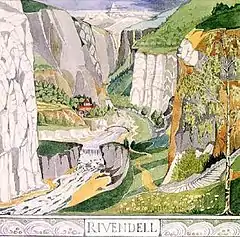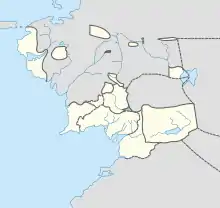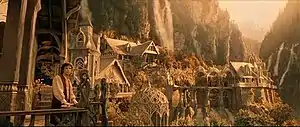Rivendell
Rivendell (Sindarin: Imladris) is a valley in J. R. R. Tolkien's fictional world of Middle-earth. It was established in the Second Age by Elrond Half-elven, who protected it with the powers of his Elven ring Vilya and ruled it until the events of The Lord of the Rings four or five thousand years later. It is an important location in Tolkien's legendarium, featured in The Hobbit, The Lord of the Rings, The Silmarillion, and Unfinished Tales.
| Rivendell | |
|---|---|
| J. R. R. Tolkien's legendarium location | |
 J. R. R. Tolkien's painting of Rivendell | |
 Location of Rivendell in Middle-earth | |
| First appearance | The Hobbit |
| Information | |
| Type | Refuge of the Elves Hidden Refuge |
| Ruler | Elrond |
| Other name(s) | Imladris Karningul Last Homely House East of the Sea |
| Location | eastern Eriador: a western valley of the Misty Mountains |
| Lifespan | S.A. 1697 - Abandoned by F.A. 120 |
| Founder | Elrond |
Elrond lived in Rivendell with his wife Celebrían (until she departed for Valinor), their sons Elladan and Elrohir, and their daughter Arwen, and many other Elves, both Noldor and Sindar. Notable Elves who lived in Rivendell included Glorfindel, Gildor, and Erestor. In some writings, featured in Unfinished Tales, Galadriel and Celeborn also lived in Rivendell for a time before they became rulers of Lothlórien. Unique among non-elves, Bilbo Baggins effectively "retired" to Rivendell as an old hobbit, before going over the sea.
Rivendell consistently represents a sanctuary, a place that feels like home. This feeling of peace may have contributed to the popularity of The Lord of the Rings during the war-troubled 1960s. Others have written that Rivendell was the home of Elvish song, illustrated by Tolkien with poetry from the hymn to Elbereth to the complex Song of Eärendil.
Origins and names

The Rivendell valley may be based upon the valley of Lauterbrunnen in Switzerland, where Tolkien had gone hiking in 1911.[1]
Rivendell is a direct translation or calque into English of the Sindarin Imladris, both meaning "deep valley". The name Rivendell is formed by two English elements: "riven" (split, cloven) and "dell" (valley). Imladris was also rendered "Karningul" in Westron, the "Common Tongue" of Middle-earth represented as English in the text of The Lord of the Rings. The house of Elrond in Rivendell is also called The Last Homely House East of the Sea, alluding to the wilderness (Rhovanion) that lies east of the Misty Mountains.[T 1]
Fictional context
Geography
Rivendell lay in eastern Eriador at the edge of a narrow gorge of the river Bruinen (one of the main approaches to Rivendell comes from the nearby Ford of Bruinen), well hidden in the moorlands and foothills of the Hithaeglir or Misty Mountains. Contrary to the map of western Middle-earth published in The Lord of the Rings, the Great East Road did not in Tolkien's view lead through Rivendell: Rivendell was maintained as a hidden valley away from the road to the High Pass.[T 2][T 3][T 4] Like Hobbiton, it is at about the same latitude as Tolkien's workplace, Oxford.[T 5]
History
Rivendell was founded in the Second Age as a "refuge and stronghold", after the destruction of the Elvish realm of Eregion (Hollin) by the Dark Lord Sauron. He had invaded Eregion to seize the Rings of power from the Elven smiths. In response, Gil-galad sent a force from Lindon, commanded by Elrond. Eregion was destroyed, and the remnants of Elrond's army and Eregion's refugees were driven north into the hills, and were besieged in the valley that became Rivendell. They were relieved by an army of Elves from Lineon and Men of Númenor. Rivendell remained as the only Elven settlement in eastern Eriador; Gil-galad gave Elrond the Ring Vilya, providing him with the power to protect Rivendell. It was attacked in the fourteenth century of the Third Age by the armies of the Witch-king of Angmar. It again withstood a siege, relieved by an Elvish force from Lothlórien. Several centuries later, Elves from Rivendell, commanded by Glorfindel, fought in the final battle against the armies of Angmar.[2][T 6]
Following the destruction of Arnor, the northern Númenórean kingdom, Rivendell became important for the remnants of its people, the Rangers of the North. Elrond held the relics of that kingdom in his keeping, namely the shards of Elendil's sword Narsil, the Sceptre of Annúminas, the Star of Elendil, and the ring of Barahir. The heirs of the chieftains of the Rangers were fostered in Rivendell as children. The greatest and last of these was Aragorn, whom Elrond treated as a son. During his time in Rivendell, Aragorn met and fell in love with Elrond's daughter, Arwen. They were married after he was crowned king of both Gondor and Arnor.[T 7]
Rivendell is an important location in the events of The Hobbit and The Lord of the Rings. Fearing the growing power of Sauron, his enemies form the White Council to allow them to debate and strategize how to confront his menace. Elrond was a prominent member of the Council, and it frequently met in Rivendell, as when the Council decided to attack Sauron in his fortress in Dol Guldur. That same year, another Council member, the wizard Gandalf, helped the Hobbit Bilbo Baggins and a company of dwarves on their quest to reclaim Erebor. On their way they stopped at Rivendell, and while there learnt how they might be able to achieve their goal.[T 2] Bilbo and Gandalf also stopped in Rivendell on their return journey.[T 4]
After his 111th birthday Bilbo retired to Rivendell, spending his time writing his memoirs and scholarly works, but his finding of the One Ring on his previous adventure set great events in motion. Frodo Baggins and his companions journeyed to Rivendell to deliver the Ring to safety from Sauron's agents, staying there for more than two months. During that time, several other Elves, Dwarves and Men arrived at Rivendell on separate errands, and at the Council of Elrond they learned that all their errands were related to the fate of the Ring. After a lengthy debate, the council decided upon destroying the Ring. The Fellowship of the Ring was formed; Aragorn's sword Narsil was reforged as Andúril; and the company departed on the quest for Mount Doom.[T 8][T 9][T 10]
Following the destruction of the One Ring at the end of the Third Age, Elrond's ring lost its power and he tired of Middle-earth. Thus at the beginning of the Fourth Age Elrond, and many of his household, left Rivendell to sail for Valinor from the Grey Havens. Though its people were diminished, Rivendell was maintained, for a while, by Elladan and Elrohir. They were later joined by Celeborn, who left East Lórien within a few years of Galadriel's departure with Elrond's party.[T 11] Shortly before he died, Aragorn told Arwen that "none now walk" in the garden of Elrond.[T 12]
Culture
Rivendell's culture was Elvish, with both the Noldor and the Sindar represented in its population and in Elrond's ancestry.[3] Through its connection to the Dúnedain there was also Númenórean influence. In Rivendell the culture, wisdom, and lore of the Elves of the Elder Days was preserved. Through the power of his ring, Vilya, Elrond could stave off the weariness of time that affected the outside world, allowing the immortal Elves to live in a somewhat timeless realm in their hidden valley.[4][T 8] On high feast days the household of Elrond told the tales and sang the songs chronicling the deeds of their history and of the Blessed Realm of Valinor.[T 8]
Despite its semi-isolation and seeming fixation on the past, Rivendell was worldly and never fully cut off from other peoples or their troubles. For outsiders it proved to be a "refuge for the weary and the oppressed, and a treasury of good counsel and wise lore",[T 13] and was visited by peoples of all races seeking sanctuary, healing, and the wisdom of Elrond. This somewhat cosmopolitan nature was remarked on by Sam Gamgee who said that there was something of everything in Rivendell, to which Frodo agreed, but added that the sea was not represented.[T 8]
Calendar
The Calendar of Imladris is briefly mentioned in Appendix D as the only Elvish calendar described (within the fiction of manuscript tradition in The Lord of the Rings) by the Hobbits in the Red Book of Westmarch. A yén, often translated "year", really means 144 of our years, 52,596 days. The Eldar liked to reckon in sixes and twelves. A 'day' of the sun they called ré, reckoned from sunset to sunset. For ritual purposes the Eldar observed a week or enquië of six days. The Elves had a regular 365-day solar year called coranar meaning "sun-round" or more commonly loa meaning "growth". The Elven year began at the spring equinox; it was divided into six seasons or 'months', with four 54-day months and two 72-day months. Five or eight extra days outside the seasons make the length of the loa 365 or 368 days. Most years are 365 days, but every twelfth year is 368 days, resulting in an average year of 365.25 days; in the "Reckoning of Rivendell" a further correction omits the three extra days in every third yén (once every 432 years), for an average year length of 52595⁄144≈365.24306 days.[T 14]
| Quenya name | Sindarin name | English translation | Duration |
|---|---|---|---|
| tuilë | ethuil | spring | 54 days |
| lairë | laer | summer | 72 days |
| yávië | iavas | autumn | 54 days |
| quellë | firith | fading | 54 days |
| hrívë | rhîw | winter | 72 days |
| coirë | echuir | stirring | 54 days |
Reception
Matthew T. Dickerson, in the J. R. R. Tolkien Encyclopedia (2006), writes that Rivendell consistently represents a sanctuary, a place that felt like home, throughout the legendarium.[2]
Jane Ciabattari writes that a major reason for the popularity of Lord of the Rings was the desire for escape among the Vietnam War generation. She compares the military-industrial complex with Mordor, and suggests that they yearned for a place of peace, just as Frodo Baggins felt an "overwhelming longing to rest and remain at peace… in Rivendell".[5]
The critic Tom Shippey contrasts the versions of the Old Walking Song sung by Bilbo and Frodo. Bilbo follows the "Road ... with eager feet", hoping to reach the peace of Rivendell, to retire and take his ease; whereas Frodo sings "with weary feet", hoping somehow to reach Mordor bearing the Ring, and to try to destroy it in the Cracks of Doom: diametrically opposed destinations and errands.[6] He notes that Rivendell was the home of Elvish song, among other things citing Tolkien's statement that the song invoking Elbereth was a hymn.[7] Shippey writes, too, that Bilbo wrote and sang the Song of Earendil in Rivendell, making use of multiple poetic devices – rhyme, internal half-rhyme, alliteration, alliterative assonance, and "a frequent if irregular variation of syntax" – to create a mysterious Elvish effect of "rich and continuous uncertainty, a pattern forever being glimpsed but never quite grasped."[8]
Shippey remarks that Tolkien, a Christian, was extremely careful with dates and timelines, but that hardly any readers notice that the Fellowship sets out on its quest on 25 December, the date of Christmas, and succeeds, destroying the Ring and causing the fall of Sauron, on 25 March, the date in Anglo-Saxon tradition for the Crucifixion.[9]
Adaptations

In Peter Jackson's 2001 film The Fellowship of the Ring, Rivendell was represented by Kaitoke Regional Park, New Zealand, though the waterfalls were added with computer-generated imagery.[11] Brian Rosebury comments that Jackson presents the Elves as sophisticated, where Tolkien made them close to nature. All the same, he writes, the film Rivendell's "architecture and ornaments are dominated by natural motifs", suggesting "integration with nature, but at one remove", something that works well for the "Portmeirion-like idyll" of the portrayed Rivendell. Rosebury describes the design as "post-Ruskinian", as in pre-Raphaelite paintings, William Morris's Arts and Crafts designs, and Art Nouveau architectural details. These differ from Tolkien's own illustrations, but in a way, Rosebury suggests, that Tolkien would have liked as it matches his dislike of industrialised manufacture.[10]
Legacy
In the period of counterculture in the Western World of the 1960s and 1970s, a commune called Maos Lyst (Mao's Delight) was founded on the island of Zealand, Denmark, in 1968, its inhabitants replacing their surnames with Kløvedal, the Danish for Rivendell. Several of them later became well-known cultural personalities in the country.[12][5] The Canadian progressive rock band Rush memorializes Rivendell in the song "Rivendell" on their 1975 studio album Fly by Night. The song focuses on the tranquillity and seemingly endless time a weary traveller could find there.[5] The Rivendell Winery operated from 1987 to 2008 in New York's Hudson River Valley.[13]
References
Primary
- This list identifies each item's location in Tolkien's writings.
- Tolkien (1955), Appendix F, "On Translation"
- Tolkien (1937), ch 3 "A Short Rest"
- Tolkien (1937), ch. 18 "The Return Journey"
- Tolkien (1937), ch. 19 "The Last Stage"
- Carpenter (1981), #294 to Charlotte and Denis Plimmer of The Daily Telegraph, 8 February 1967
- Tolkien (1980), part 2, "The Second Age" ch. 4 "The History of Galadriel and Celeborn"
- Tolkien (1955), Appendix A: The Tale of Aragorn and Arwen
- Tolkien (1954), book 2, ch. 1 "Many Meetings"
- Tolkien (1954), book 2, ch. 2 "The Council of Elrond"
- Tolkien (1954), book 2, ch. 3 "The Ring Goes South"
- Tolkien (1955), Appendix B, "The Great Years"
- Tolkien (1955), Appendix A, "The Númenórean Kings", "The Tale of Aragorn and Arwen"
- Tolkien (1977), "Of the Rings of Power and the Third Age"
- Tolkien (1955), Appendix D, "The Calendars"
Secondary
- MacEacheran, Mike (24 May 2014). "In Alpine villages, Hobbits lurk". BBC. Retrieved 18 August 2020.
- Dickerson 2013, pp. 573–574.
- Tolkien (1977), "Akallabeth"
- Tolkien (1980), "The History of Galadriel and Celeborn", "Concerning Galadriel and Celeborn"
- Ciabattari, Jane (20 November 2014). "Hobbits and hippies: Tolkien and the counterculture". BBC Culture.
- Shippey 2005, p. 213.
- Shippey 2005, p. 230.
- Shippey 2005, pp. 218–219.
- Shippey 2005, p. 227.
- Rosebury 2003, pp. 212–213.
- "Kaitoke Regional Park, Wellington, New Zealand". Newzealand.com. Retrieved 15 January 2020.
- "1960'erne: Ungdomsliv: Eksperimenterne" (in Danish). DR (Danish Radio). 26 October 2010. Retrieved 18 August 2020.
- Thompson, Lenn (26 October 2007). "Rivendell Winery Location for Sale in the Hudson Valley". New York Cork Report. Retrieved 29 June 2020.
Sources
- Carpenter, Humphrey, ed. (1981), The Letters of J. R. R. Tolkien, Boston: Houghton Mifflin, ISBN 0-395-31555-7
- Dickerson, Matthew (2013) [2006]. "Rivendell". In Drout, Michael D. C. (ed.). J. R. R. Tolkien Encyclopedia. Routledge. pp. 573–574. ISBN 978-0-415-86511-1.
- Rosebury, Brian (2003) [1992]. Tolkien : A Cultural Phenomenon. Palgrave. ISBN 978-1403-91263-3.
- Shippey, Tom (2005) [1982]. The Road to Middle-Earth (Third ed.). HarperCollins. ISBN 978-0261102750.
- Tolkien, J. R. R. (1937), Douglas A. Anderson (ed.), The Annotated Hobbit, Boston: Houghton Mifflin (published 2002), ISBN 0-618-13470-0
- Tolkien, J. R. R. (1954). The Fellowship of the Ring. Houghton Mifflin (published 1987). ISBN 0-395-08254-4.
- Tolkien, J. R. R. (1955), The Return of the King, The Lord of the Rings, Boston: Houghton Mifflin (published 1987), ISBN 0-395-08256-0
- Tolkien, J. R. R. (1977), Christopher Tolkien (ed.), The Silmarillion, Boston: Houghton Mifflin, ISBN 0-395-25730-1
- Tolkien, J. R. R. (1980), Christopher Tolkien (ed.), Unfinished Tales, Boston: Houghton Mifflin, ISBN 0-395-29917-9
.jpg.webp)
